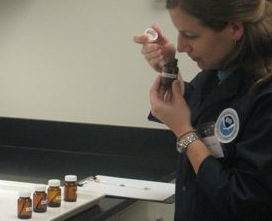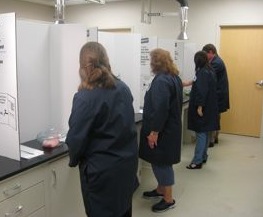The Nose Knows
Air Date: Week of June 25, 2010

Julie Anderson takes a whiff of Louisiana crude. (Photo: Phoebe Judge)
NOAA and the International Food Protection Training Institute are helping Gulf state food safety workers develop their sense of smell. The organizations are offering two-day seafood sensory workshops to train professionals to detect seafood that may be contaminated by oil. Mississippi Public Broadcasting’s Phoebe Judge has our story.
Transcript
YOUNG: It’s Living on Earth, I’m Jeff Young. NOAA - The National Oceanic and Atmospheric Administration - has closed about a third of federal waters in the Gulf of Mexico to commercial and recreational fishing. One of the major concerns over the Gulf spill is how to detect contaminated seafood. Mississippi Public Broadcasting’s Phoebe Judge reports on the effort to beef up seafood inspection.
[SNIFFING, PLATE CLANKING]
JUDGE: Julie Anderson stands over a piece of red snapper at NOAA’s Mississippi Laboratories in Pascagoula. She takes a deep breath and leans down to have a smell.
ANDERSON: Breathe in, take some bunny sniffs, just short quick breathes to see if we can detect any sort of oily petro smell. Like snapper has a very briny smell to it. You can kind of smell the salt coming off.

Julie Anderson takes a whiff of Louisiana crude. (Photo: Phoebe Judge)
JUDGE: Anderson is an employee of the Louisiana Sea Grant Consortium in Baton Rouge, and she is one of 60 individuals who have come to take part in a two-day seafood sensory training course to detect seafood that may be contaminated by oil. Jerry Wojtala, is director of the International Food Protection Training Institute, the group running the session.
WOJTALA: This is a time tested, and it is quite a scientific and statistically valid method, of using human senses and in this case, noses, to detect problems with the seafood.
JUDGE: Wojtala says immediately after the oil spill began, his organization started getting phone calls from Gulf Coast states interested in receiving the seafood training. But with many of those states facing major budget shortfalls, there wasn’t any money to send officials to travel to the institute’s headquarters in Michigan-- so they brought the training directly to the Gulf.
WOJTALA: So we have fisheries people from states that are out evaluating the state waters. We have people that are with health departments or agriculture departments, who are looking at wholesalers or processors, and we have people with local health departments who are at the restaurants.
JUDGE: The goal is to place trained screeners in as many points in the system as possible to try and catch any oil-tainted seafood. But it’s the goal of NOAA to make sure there isn’t much of that oil-tainted seafood that ever makes it onshore. Since just after the oil spill began on April 22nd NOAA has collected 65-75,000 fish and invertebrate species samples from Gulf waters. Usually they do annual surveys on species, now they are sampling daily, targeting 41 commercially important species. Lisa DeFosse is director of the Mississippi Laboratories in Pascagoula.

Participants at the NOAA/International Food Protection Training Institute sensory training session learn how to detect oil taint by smelling the seafood. (Photo: Phoebe Judge)
DEFOSSE: We are basically blanketing the entire Gulf of Mexico. We started in the areas where the oil initially was: Louisiana, Mississippi, Alabama. Now we are moving into Florida and Texas and also into the deeper waters. If there is even an indication of an oil taint then those areas would not be open for fishing, and then we would follow up with more intensive chemical testing.
JUDGE: And Jerry Wojtala says with the amount of samples now being taken of seafood in the Gulf as a result of the spill it’s even more important to have as many trained screeners as possible.
WOJTALA: There’s no way to be able to test every load of fish that is harvested, it would be exponentially expensive to do that. It’s a way to screen samples, and get the things that the human nose can detect out of the system and worry about the things we can’t detect.
[AMBIANCE OF TESTING LAB]
JUDGE: Back in the sensory training lab Julie Anderson has moved to a reference table where she is smelling test samples of different types of petroleum, like Louisiana and Alaskan crude.
ANDERSON: The Louisiana crude has a much lighter smell to it, it is not as heavy, it’s not quite the same burning smell that you get from the Alaskan crude for example. And then we have a yeast sample, a rice, ammonia, and vinegar, which are all smells that can come off of seafood naturally.
JUDGE: Another student, Jon Bell, is a professor of food science from New Orleans and he is working on a new shrimp quality certification program for Louisiana. He says he’s amazed at how well the nose can detect the oil even at low levels.
BELL: But I get it as more of a dirty motor oil or tarry substance, but it is also a feeling, it’s a nasal tinge in your sinuses. I find that I can feel it, as well as smell it, very easily.
JUDGE: With a large portion of state and federal waters now closed to fishing, Jerry Wojtala says a lot of the hard decisions are yet come.
WOJTALA: When do you open a waterway? How do you know it is safe? Sampling has to take place. How do you if know if fishermen have caught some harvested in a certain area that is safe. All that has to be evaluated. We want to increase the capacity of the trained noses, if you will, that are out there so that we can do a lot of this hard work ahead.
JUDGE: Wojtala says they plan on training as many state and local officials as necessary to help shore up what he says is the first line of defense in ensuring the nations seafood safety. For Living on Earth, I’m Phoebe Judge in Gulfport, Mississippi.
Links
International Food Protection Training Institute (IFPTI)
Living on Earth wants to hear from you!
Living on Earth
62 Calef Highway, Suite 212
Lee, NH 03861
Telephone: 617-287-4121
E-mail: comments@loe.org
Newsletter [Click here]
Donate to Living on Earth!
Living on Earth is an independent media program and relies entirely on contributions from listeners and institutions supporting public service. Please donate now to preserve an independent environmental voice.
NewsletterLiving on Earth offers a weekly delivery of the show's rundown to your mailbox. Sign up for our newsletter today!
 Sailors For The Sea: Be the change you want to sea.
Sailors For The Sea: Be the change you want to sea.
 The Grantham Foundation for the Protection of the Environment: Committed to protecting and improving the health of the global environment.
The Grantham Foundation for the Protection of the Environment: Committed to protecting and improving the health of the global environment.
 Contribute to Living on Earth and receive, as our gift to you, an archival print of one of Mark Seth Lender's extraordinary wildlife photographs. Follow the link to see Mark's current collection of photographs.
Contribute to Living on Earth and receive, as our gift to you, an archival print of one of Mark Seth Lender's extraordinary wildlife photographs. Follow the link to see Mark's current collection of photographs.
 Buy a signed copy of Mark Seth Lender's book Smeagull the Seagull & support Living on Earth
Buy a signed copy of Mark Seth Lender's book Smeagull the Seagull & support Living on Earth

